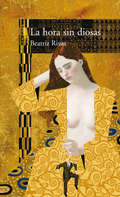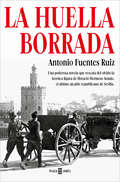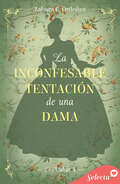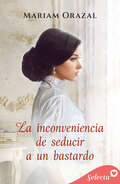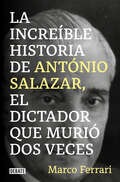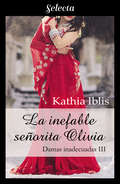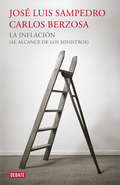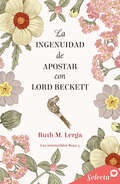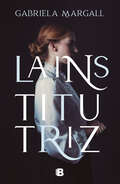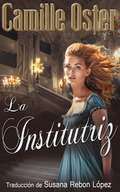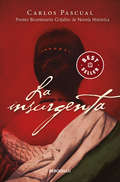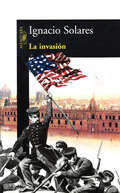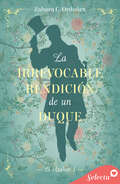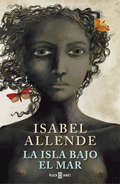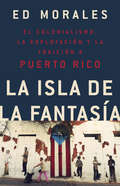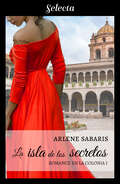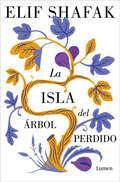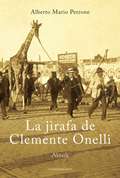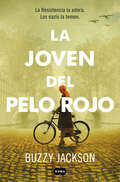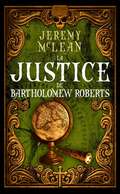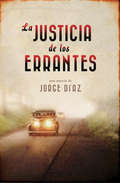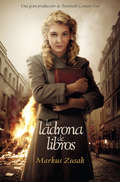- Table View
- List View
La hora sin diosas
by Beatriz RivasEn este libro, Beatriz Rivas relata las memorias de Daniel Ponty, quien conoció a varios personajes históricos. De la autora de Dios se fue de viaje y Lo que no mata, enamora, Beatriz Rivas. Daniel Ponty dicta sus memorias. Memorias de Daniel Ponty. Una vida privilegiada, pues le tocó vivir en París y Viena entre 1890 y 1939, y amar a personajes históricos: Lou Andreas-Salomé, Hannah Arendt, Alma Mahler; y por extensión a Rilke, Nietzsche, Freud, Benjamin, Klimt, Rodin, entre otros.
La huella borrada: Una poderosa novela que rescata del olvido la heroica figura de Horacio Hermoso Araujo, el último alcalde republicano de Sevilla
by Antonio FuentesLa apasionante vida novelada del último alcalde republicano de Sevilla. Una ficción basada en hechos reales, rescatada del olvido a partir de los recuerdos de uno de los supervivientes de la historia. Horacio Hermoso Araujo, último alcalde republicano de Sevilla, reflexiona mientras se encuentra cautivo de las tropas franquistas sobre su carrera y cómo ha llegado a esa situación. Mientras, su hermano trata de salvarle de la muerte en una ciudad conmocionada por el Alzamiento Nacional y la primera batalla de la Guerra Civil. La huella borrada constituye una exhaustiva investigación convertida en novela en torno a la figura de Horacio Hermoso a partir de los testimonios de familiares y conocidos. Supone también la recuperación de una poderosa historia real al borde del olvido, una sobre las muchas personas que aún se encuentran en las fosas comunes creadas durante el franquismo. En definitiva, un ambicioso proyecto periodístico convertido en una novela desgarradora.Antonio Fuentes Ruiz (Rota, Cádiz, 1979) es un periodista andaluz, con experiencia en radio y prensa escrita (Onda Cero, Europa Press, Grupo Joly, ...), cuya carrera profesional ha estado enfocada en la investigación y las preocupaciones sociales. Actualmente trabaja en el Defensor del Pueblo Andaluz. Esta es su primera novela.
La inconfesable tentación de una dama (El azahar #Volumen 4)
by Zahara C. Ordóñez«Pensé que serías una tormenta devastadora y ahora no puedo dejar de pensar en ti como la lluvia de otoño que besa los campos tras un verano de sed. Tan necesaria como perfecta». Lidia Alborada lleva toda la vida enamorada de Andrés Ferrera y está convencida de que se casará con él en cuanto el joven termine sus estudios. No hay día en el que no le escriba una carta de amor y sueñe con su boda. Pablo Morente es hijo de criadores de caballos y ha trabajado al servicio de grandes señores. Sin embargo, un desafortunado accidente se llevó a su padre y hundió a su familia en la desgracia. Cuando cree que no tendrá más oportunidades, un inesperado giro de su destino lo lleva a trabajar en casa de los Alborada. La llegada de Pablo trastocará los planes de Lidia. Ha jurado amar a Andrés, pero ¿quién podría resistirse a un mozo de cuadras con una mirada capaz de doblegar la más férrea de las voluntades? ¿Quién podría resistirse a amar lo que más desea?
La inconveniencia de seducir a un bastardo (Serie Chadwick #Volumen 4)
by Mariam OrazalCuando el poder de la pasión va más allá de las normas. Cuando el ímpetu femenino se impone incluso al más férreo control. El corazón aventurero de lady Arabella Gordon la ha llevado en numerosas ocasiones al borde del escándalo. Incorrecta y rebelde, está decidida a vivir según su voluntad, y eso incluye al esposo menos apropiado en el que podría haber puesto sus ojos. Michael Callahan no es otra cosa que un desposeído de la alta sociedad, un bastardo criado en las minas de carbón. Convertido ahora en un magnate, ha conseguido el respeto que su nacimiento le negó, pero todo podría echarse a perder si no logra apartar sus manos de la joven aristócrata que ha llegado a obsesionarle. ¿Logrará Arabella romper la coraza de un hombre que no conoce el amor?¿Sabrá Michael comprender a tiempo que ella es la única que puede curarlo?
La increíble historia de António Salazar, el dictador que murió dos veces.
by Marco FerrariUna crónica apasionante de la dictadura más longeva de Europa y de su asombroso final. Durante cuarenta años, Portugal y su inmenso imperio colonial fueron dirigidos por António Salazar, un hombre lleno de contradicciones. Este brillante ensayo recorre las peculiaridades del Estado Novo, desde los años treinta con Hitler, Franco y Mussolini, hasta el final de sus días en los años setenta, marcados por un episodio, tan fascinante como patético, a partir del golpe que el dictador recibió en la cabeza en una visita al callista. Al quedar impedido, se orquestó a su alrededor una impresionante puesta en escena con el fin de ocultarle que ya no era él quien gobernaba. Esta incluía reuniones de gabinete simuladas, visitas de Estado falsas y, sobre todo, un sistema de medios de comunicación hecho a medida para Salazar, con entrevistas en radio y televisión y ejemplares de su diario favorito solo para él. Exseminarista y creador de un sutil sistema de represión, Salazar se libró de la Segunda Guerra Mundial cediendo bases a los Aliados en las Azores y vendiendo material a los nazis. Se dedicó a construir duras penitenciarías en islas remotas y en antiguas fortalezas medievales, y convirtió Lisboa en una ciudad llena de espías. El régimen corporativista y autoritario que creó fue derrocado por la Revolución de los Claveles, que trajo consigo la vuelta de Portugal a Europa.
La inefable señorita Olivia (Damas inadecuadas #Volumen 3)
by Kathia IblisLa tercera entrega de la apasionante serie «Damas inadecuadas». Una joven de tierras lejanas hallará el amor en brazos del hombre más inesperado. La joven Olivia Wentworth, dama inadecuada como ninguna otra debido a sus orígenes, tan solo desea poder cuidar de su enfermo padre, el duque de Devonshire, y luego regresar a su hogar junto a su madre. Pero para ello debe sobrevivir a su presentación en sociedad sin producir un solo escándalo. Ignora que, sin siquiera intentarlo, un pequeño desencuentro en la nieve cambiará su destino. Lord Wulfgar Ambrose Herbert, conde de Pembroke, está hastiado de las jóvenes casaderas que tan solo anhelan de él su título. Es así como, intentando alejarse de todo su mundo, choca con de una misteriosa joven que se volverá su obsesión. Sus caminos parecen destinados a unirse, pero envidias y adversarios del pasado están decididos a no permitir que hallen la felicidad. ¿Podrá acaso la inefable joven demostrar una vez mas que es capaz de lograrlo todo por amor? ¿Será el duque capaz de conquistarla o estará destinado a perderla?
La inflación (al alcance de los ministros)
by Carlos Berzosa José Luis SampedroLa gran obra de Sampedro sobre la inflación, revisada y actualizada. En este libro sobre la inflación, José Luis Sampedro y Carlos Berzosa procuran mostrar al ciudadano lo que la ciencia económica oficial prefiere ignorar o enmascarar. La inflación, un fantasma que parecía controlado desde mediados de los noventa, vuelve a estar en boca de todos, ya que es la excusa en la que se escudan las autoridades económicas y financieras para adoptar políticas restrictivas que asfixian aún más las débiles señales de crecimiento. En su ya clásico estudio, José Luis Sampedro, uno de los economistas más respetados de España, diseccionaba la inflación y la hacía comprensible para el gran público. Además, frente a la ortodoxia de la teoría económica, exponía una visión mucho más crítica en la que la inflación era una herramienta fundamental del sistema. En el amplio epílogo de Carlos Berzosa que actualiza la obra se repasa la historia de la inflación desde que fue controlada en los noventa, y se analiza por qué ha vuelto y a qué intereses beneficia su retorno.
La ingenuidad de apostar con Lord Beckett (Los irresistibles Beau #Volumen 5)
by Ruth M. LergaUna dama que siente que la sociedad no la deja respirar, un conde que se ofrece como la brisa para que tenga paz y un hombre oculto tras unas cartas que entra en su vida como un huracán. Los vientos soplan con fuerza para lady Elisabeth. Lady Elisabeth Cavendish no está interesada en las actividades femeninas, sino en lo que las damas se pierden por el hecho de ser mujeres. Como en muchas veladas, se esconde con una de sus primas para evitar bailar y plantea una apuesta loca que, desde luego, la otra no acepta. Pero poco después recibe la carta anónima de un hombre que le propone llevar a cabo los términos de su desafío. El caballero la ayudará a introducirse en White’s y, de logarlo, le exigirá a cambio una compensación por determinar. Una oferta que la curiosidad de Elisabeth no puede ignorar, a pesar del riesgo que supone. Lord Andrew Beckett, conde de Harlech, se enamora de Elisabeth en cuanto la ve, pero, conocedor de su desinterés por casarse, halla el modo de seducirla en secreto a base de proposiciones arriesgadas y diversión poco recomendable. Lo que no sabe es que, al hacerlo, al mismo tiempo que se acerca a la joven la aleja de su lado, pues también lord Beckett ha llamado su atención. Lady Elisabeth ha creído encontrar, al fin, a un caballero con el que ser feliz, pero ahora que la aventura la asalta por sorpresa duda entre vivir según su espíritu inconformista o ser prudente y no poner en riesgo su reputación, pues el más mínimo error le impediría casarse con el único hombre al que podría amar. ¿A quién obedecer cuando te enamoras de dos hombres, al corazón o al alma?
La inolvidable Guerra de Vietnam: La Guerra Americana en Vietnam - Guerra en la jungla
by Scott S. F. Meaker I. FernandezBreve historia de Vietnam. En la Guerra de Vietnam se luchó como en cualquier otra guerra pero terminó con ambas partes creyendo que habían vencido. Eso sí, no arrancó con una declaración de guerra como tal. La gran cantidad de luchas por el poder a lo largo de su historia es abrumadora. Las batallas fueron cortas e intensas y se desarrollaron en las junglas y arrozales. Los métodos guerrilleros tuvieron gran peso en esta guerra.
La insomne Aurora: La pluma del Amor
by Maruska CreanzaEn una calurosa noche de verano del 1650, el rey Stéfano, atrapado por un calor tormentoso, decidió levantarse y tomar un poco de agua fresca del pozo. Y mientras recorría, abatido, el largo corredor de su castillo, vislumbro a lo lejos una luz. Resopló y sacudió la cabeza. “¡Es Aurora, seguramente!”. Murmuró. Él sabía el tremendo defecto que se había apoderado de su única hija. El rey la vio tambalearse e ir hacia las cocinas reales. Hoy había sido servido para el almuerzo, cordero con patatas, y su voraz hija cada tanto hacia asaltos a la despensa. El sacudió la cabeza, para no verla clavar los caninos en la carne, y dar batalla sin descanso a las patatas, decidió que se habría aguantado la sed. Su esposa Serafina, la reina, que era cualquier cosa excepto tranquila, lo vio entrar enojado. “¿Entonces, esposo real? ¿El agua?” El la miró resoplando. Serafina con la mascarilla verde a la sandía no era precisamente un lindo espectáculo, pero era muy quisquillosa, por tanto, sobre algunas cosas, era mejor callarse... por la paz familiar! “Se me pasó la sed... he visto a Aurora dirigirse hacia las cocinas!”
La institutriz
by Gabriela MargallTras casi quince años de trabajar como institutriz en Argentina Elizabeth Shaw está decidida a volver a su pueblo natal en Inglaterra. Cuando su regreso es casi un hecho, una familia -a la que está unida por fuertes lazos- requiere de sus servicios y se reencontrará con Tomás Hunter, su amor de la juventud. ¿Podrá el amor vencer una red de secretos y un oscuro pasado? ¿A qué lugar pertenecemos? ¿Al lugar donde nacimos o a donde viven nuestros amores? ¿Al lugar con el que soñamos todas las noches? Elizabeth Shaw desea volver al pueblo donde nació, el puerto de Fowey, en el sur de Inglaterra. Huérfana desde los dieciséis años, su existencia ha transcurrido en casas ajenas, educando niños y jovencitas de alta sociedad en Buenos Aires. Disciplinada y dueña de firmes convicciones, su trabajo le permitió hacerse un nombre y convertirse en una institutriz apreciada y respetada. Cuando su regreso a Inglaterra es casi un hecho, una familia -a la que está unida por fuertes lazos- requiere su experiencia. La lealtad y sus sentimientos todavía vivos la llevarán a entrar en un hogar donde todas sus convicciones serán cuestionadas: un antiguo amor volverá a su vida, dos niños desamparados pondrán a prueba su capacidad y Elizabeth deberá lidiar con la pregunta sobre su verdadero origen.
La institutriz: un romance gótico victoriano
by Camille OsterViajar fuera de Inglaterra no estaba en la mente de la señorita Estelle Winstone, cuando recibió una respuesta a su anuncio postulándose como institutriz. El hecho de tener que viajar hasta Hungría, provocó que los nervios le revolvieran sus entrañas, al igual que tener que conocer al misterioso conde que sería su patrón. Al llegar a su destino, además de ser incapaz de hablar en húngaro ni siquiera lo básico, vio que el lugar estaba enclavado en unas montañas remotas, donde lobos hambrientos merodeaban fuera del sombrío y terrorífico castillo medieval en donde viviría, y el cual tenía una larga historia de tragedias, además de haber sido el escenario reciente de horrendos sucesos.
La insurgenta (Premio Bicentenario Grijalbo de Novela Histórica, 2010)
by Carlos PascualLa portentosa novela ganadora del Premio Grijalbo Bicentenario de Novela Histórica. Se trata de una divertida novela sobre la "Madre de la Patria": Leona Vicario. Agosto de 1842. Leona Vicario, la heroína insurgente, ha muerto. Y ha muerto a mitad de ese torbellino que es la República de Antonio López de Santa Anna, "un mal llamado Estado que no es más que un charco pestilente en el que saltan los renacuajos ambiciosos y los ajolotes oportunistas". Por lo tanto, su gobierno decide aprovechar políticamente la pertinencia de su muerte... El fallecimiento de Leona Vicario, la Madre de la Patria -cosa que pocos saben el día de hoy-, concita un abigarrado concierto en el que participan los más disímbolos personajes de la vida pública de entonces: Lucas Alamán y Carlos María de Bustamante, arrieros y criadas, Benito Juárez y la anciana Güera Rodríguez, damas de sociedad y pelados, Valentín Gómez Farías y antiguos inquisidores, héroes vivos, viejos militares, monjas profesas y exclaustradas, deudos, parientes y enterradores, así como el viudo de Leona Vicario, don Andrés Quintana Roo. Con la fina ironía que caracteriza su trabajo, Carlos Pascual realiza una atinada radiografía de la época que reconstruye, y lo hace con rigor histórico y un certero y dramático manejo del lenguaje. A través de una ágil narrativa, da vida a los personajes históricos con unas cuantas pinceladas; presenta, además, un profundo retrato psicológico de Leona Vicario, en el que resalta sus cualidades humanas sin caer nunca en la idealización. Con oficio de artesano, Carlos Pascual coloca cada una de las voces que componen esta novela en su lugar justo, hasta crear el complejo mosaico en el que se convierte La insurgenta, obra con la que obtuvo el Premio Bicentenario Grijalbo de Novela Histórica.
La invasión
by Ignacio SolaresAbelardo redacta sus recuerdos de juventud, que están entrelazados con la intervención norteamericana de 1847. México, fines del siglo XIX. Abelardo escribe sus recuerdos de juventud, ineludiblemente entrelazados con la intervención norteamericana de 1847. Atestigua el proceso creativo su esposa, una mujer liberal que cuestiona y motiva a Abelardo, y es uno de sus principales motivos para escribir. Es sabido lo que pasó entonces: la mitad del territorio mexicano pasó a manos del incipiente imperio; hubo episodios heroicos y episodios vergonzosos, próceres, arribistas, traidores. Pero también, en medio de la catástrofe nacional, vocaciones, voluntades y pasiones individuales, como la de la pareja que rememora y la del doctor Urruchúa, obsesionado por los gérmenes.
La irrevocable rendición de un duque (El azahar #Volumen 1)
by Zahara C. Ordóñez«Me disponía a librar una guerra sin saber que, en cuanto mirase a tus ojos, firmaría la más dulce de las rendiciones». Samuel Alborada ha heredado el título de duque y las deudas de su padre. Como nuevo cabeza de familia es su responsabilidad mantenerla a flote. Conocedor de una inversión que podría solucionar sus problemas, se dispone a salvar su legado. Leire Narváez tomó las riendas del negocio familiar desoyendo las habladurías que decían era imposible que una mujer pudiera conseguir nada en un mundo de hombres. Ahora se ha hecho valer y su nombre pesa tanto como su apellido. Cuando una ventajosa inversión llega a sus oídos, no duda un segundo en lanzarse a ella. Nada más verse, Samuel y Leire se declaran la guerra. Ella lo juzga por su prejuicios; él por su descaro. Se odian y se harán la vida imposible. Pronto se darán cuenta de que del odio al amor también hay un paso.
La isla bajo el mar
by Isabel AllendePara ser una esclava en el Saint-Domingue de finales del siglo XVIII, Zarité había tenido buena estrella: a los nueve años fue vendida a Toulouse Valmorain, un rico terrateniente, pero no conoció ni el agotamiento de las plantaciones de caña ni la asfixia y el sufrimiento de los trapiches, porque siempre fue una esclava doméstica. Su bondad natural, fortaleza de espíritu y honradez le permitieron compartir los secretos y la espiritualidad que ayudaban a sobrevivir a los suyos, los esclavos, y conocer las miserias de los amos, los blancos. Zarité se convirtió en el centro de un microcosmos que era un reflejo del mundo de la colonia: el amo Valmorain, su frágil esposa española y su sensible hijo Maurice, el sabio Parmentier, el militar Relais y la cortesana mulata Violette, Tante Rose, la curandera, Gambo, el apuesto esclavo rebelde… y otros personajes de una cruel conflagración que acabaría arrasando su tierra y lanzándolos lejos de ella. Al ser llevada por su amo a Nueva Orleans, Zarité inició una nueva etapa en la que alcanzaría su mayor aspiración: la libertad. Más allá del dolor y del amor, de la sumisión y la independencia, de sus deseos y los que le habían impuesto a lo largo de su vida, Zarité podía contemplarla con serenidad y concluir que había tenido buena estrella. From the Hardcover edition.
La isla de la fantasia: El colonialismo, la explotacion y la traicion a Puerto Rico
by Ed MoralesA crucial, clear-eyed accounting of Puerto Rico's 122 years as a colony of the US.Since its acquisition by the US in 1898, Puerto Rico has served as a testing ground for the most aggressive and exploitative US economic, political, and social policies. The devastation that ensued finally grew impossible to ignore in 2017, in the wake of Hurricane María, as the physical destruction compounded the infrastructure collapse and trauma inflicted by the debt crisis. In Fantasy Island, Ed Morales traces how, over the years, Puerto Rico has served as a colonial satellite, a Cold War Caribbean showcase, a dumping ground for US manufactured goods, and a corporate tax shelter. He also shows how it has become a blank canvas for mercenary experiments in disaster capitalism on the frontlines of climate change, hamstrung by internal political corruption and the US federal government's prioritization of outside financial interests.Taking readers from San Juan to New York City and back to his family's home in the Luquillo Mountains, Morales shows us the machinations of financial and political interests in both the US and Puerto Rico, and the resistance efforts of Puerto Rican artists and activists. Through it all, he emphasizes that the only way to stop Puerto Rico from being bled is to let Puerto Ricans take control of their own destiny, going beyond the statehood-commonwealth-independence debate to complete decolonization.
La isla de los secretos (Un romance en la colonia #Volumen 1)
by Arlene SabarisAmérica a finales de 1700. Los viajes desde diversos puertos de España hacia el nuevo continente iniciaron por el Caribe. La Hispaniola era conocida como un paraíso terrenal indiscutible y fuente inagotable de riqueza para los comerciantes... El Vizconde de Salinas había aprovechado el poder inherente a su nobleza para ampliar su fortuna siendo uno de los nobles españoles que abandonaron Cádiz para convertirse en hacendados en la parte este de la isla. Su mujer y sus hijas lo convencieron de dejarlas pasar unos meses con él en el nuevo continente, abandonando la comodidad que les daba su posición. Modestia, honestidad y obediencia era todo lo que el padre esperaba de sus tres hijas mientras durara su estancia en la Nueva España. Sofía y sus hermanas, Lucía y Leonor, entusiasmadas por la vida en la isla, los nuevos amigos y la experiencia de un ambiente distinto a todo lo que conocían, solo deseaban que aquella aventura no terminara nunca. Las jovencitas, todas menores de veintiún años, ven muy pronto sus deseos hechos realidad cuando conocen vecinos de su edad e inician una amistad de verano que pronto se convertirá en mucho más, en especial para el joven Alonso y la mayor de las hermanas, Sofía. El destino, sin embargo, terminará por develar secretos que el joven Alonso guarda sobre su verdadera identidad y romperá las esperanzas del primer y único amor de la joven Sofía. El vizconde, consciente de que la juventud y belleza de Sofía pueden convertirse en un amuleto de la suerte para sus propios planes, si logra que la joven acceda a casarse con el Marqués de Ferrand, luchará con cualquier obstáculo que se atraviese en su camino, incluso si ello significa sacrificar la felicidad de su propia hija. ¿Podrá el amor superar todas las dificultades, aun cuando sean tan poderosas como el honor, la sociedad y el dinero? ¿Será capaz el destino de destruir el lazo que los une, o por el contrario será precisamente el que los ate para siempre?
La isla del árbol perdido
by Elif ShafakLa nueva novela de la finalista del Premio Booker, con más de 300.000 lectores: «Preciosa y desgarradora» (Margaret Atwood) «Maravillosa». Mary Beard * «Una voz única en la literatura mundial». Ian McEwan * «Un libro que te transforma». Naomi Klein * «Shafak crea con sus palabras un nuevo hogar para los lectores». Colum McCann NOMINADA AL WOMEN'S PRIZEFINALISTA DE LOS PREMIOS COSTA BOOK En un convulso 1974, mientras el ejército turco ocupa el norte de Chipre, Kostas, un griego cristiano, y Defne, una turca musulmana, se reúnen en secreto bajo las vigas ennegrecidas de la taberna La Higuera Feliz, donde cuelgan ristras de ajos, cebollas y pimientos. Allí, lejos del fragor de la guerra, crece a través de una cavidad en el techo una higuera, testigo del amor delos dos jóvenes, pero también de sus desencuentros, de la destrucción de Nicosia y de la trágica separación de los amantes. Décadas más tarde, en el norte de Londres, Ada Kazantzakis acaba de perder a su madre. A sus dieciséis años, nunca ha visitado la isla en la que nacieron sus padres y está desesperada por desenredar años de secretos, división y silencio. La única conexión que tiene con la tierra de sus antepasados es un Ficus carica que crece en el jardín de su casa. La isla del árbol perdido es una historia llena de magia sobre la pertenencia y la identidad, el amor y el dolor, y la asombrosa capacidad de regeneración a través de la memoria La crítica ha dicho:«Shafak es una fuerza de la naturaleza que atesora reconocimientos y centenares de miles de lectores.»Daniel Arjona, El Confidencial («12 novedades editoriales que te volaran la cabeza») «La isla del árbol perdido despliega ternura y humor. Su lectura me produjo un intenso placer».Siri Hustvedt «Una voz única en la literatura mundial».Ian McEwan «Shafak crea con sus palabras un nuevo hogar para los lectores».Colum McCann «Una novela mágica y maravillosa».William Boyd «Una hermosa novela sobre la isla de Chipre y sus habitantes, heridos y llenos de cicatrices, que nos enseña que solo el amor puede curar lo que está roto».Berhard Schlink «Una obra poderosa y apasionante, que te hechiza y te desgarra con gran delicadeza».Financial Times «Emocionante. [...] Shafak sabe [...] rompernos el corazón».The Sunday Times «Hechizante. [...] Un tapiz de emociones intensas hilado con fibras de luz».The Sunday Telegraph «Hermosa y feroz».The Guardián «Maravillosa».Mary Beard «Una historia de amor terriblemente tierna. [...] Un libro que te transforma».Naomi Klein «Una de las mejores escritoras contemporáneas».Hanif Kureishi «Shafak crea con sus palabras un nuevo hogar para los lectores».Colum McCann «Humana y encantadora».Mail on Sunday «Una historia mágica sobre la naturaleza, la humanidad y el amor. [...] Preciosa».Time
La jirafa de Clemente Onelli
by Alberto Mario PerroneLa novela va al encuentro de la figura de Clemente Onelli, inmigranteitaliano director del jardín zoológico de Buenos Aires desde 1904 hasta1924 resultado del crisol de razas que nos legó el primer Centenario. Se llamaba Clemente Onelli: era petiso, tenía bigote, usaba sombreroblanco y anteojos con marco de oro. Fue el que en 1912 condujo a unajirafa con una simple rienda desde el puerto hasta Palermo, el queexploró la Patagonia como ayudante del perito Moreno durante elconflicto con Chile, el que impulsó una expedición a la caza de unplesiosaurio en los lagos del Sur, el que ayudó a mujeres indígenas aestablecer una fábrica de tejidos tradicionales. Ese fue Onelli, el queemprendió esas y otras muchas empresas absurdas para el Buenos Aires decomienzos del siglo XX.Hay una joven buscando información para un investigador que escribirá unlibro sobre la vida de Onelli. Ella está convencida de que fue eseextranjero y no el reconocido y linajudo Moreno quien creó el primerparque nacional. "Esas son cosas de Onelli."El personaje Clemente Onelli se recorta en la explosión del país quehereda el empuje del 80. Siendo un simple inmigrante, se convirtió enalguien reconocido y estimado a nivel nacional. Fue el secretario delperito Moreno, y se ocupó de correr la desembocadura de un río duranteel conflicto con Chile.Una personalidad con múltiples facetas y un emprendedor nato que hastatrató de crear telas artesanales indígenas, criar gallinas cuando seimportaban huevos y alimentar niños abandonados con leche de una granjadentro del zoológico de Buenos Aires. También creó los zoológicos deParque Patricios, Saavedra, La Plata y Córdoba y junto a su esposa luchóa favor de los nativos del Sur.Este mismo inmigrante romano, que llegó con una mano atrás y otraadelante, tuvo también trato directo con Roca, Mitre, Mansilla, Lugones,Horacio Quiroga, Oliverio Girondo y otras personalidades de su tiempo.La novela va al encuentro de esa figura curiosa, inquieta y estimulante,resultado de nuestro crisol de razas, como un apasionado rompecabezasdonde logramos ver, con ojos de nuestro tiempo, una especie de relumbrónvital de lo que nos legó el primer Centenario.
La joven de las líneas ley
by Kate Carson Consuelo CardozoDescripción del libro: ¿Una amante de libros sobre romances en Escocia? ¡La joven de las líneas ley te sumergirá en una historia de amor que trasciende el tiempo! La serie de La joven de las líneas ley escrita por Kate Carson es un mundo cautivante - ¡Déjate llevar! Luego de que un trágico accidente la dejara huérfana y sin hogar, Millie Canvers está desesperada por hallar su lugar en el mundo y la familia que siempre quiso. Cuando el patriarca del Clan MacAllister le propone una cruzada bastante inusual, Millie acepta sin pensarlo dos veces y viaja en el tiempo a 1345, Leith, Escocia. Después de llegar a través de las líneas ley, sale a la luz el significado que oculta una serie de pesadillas recurrentes, y comienza la verdadera travesía de Millie. Salvar al clan MacAllister de la ruina es sólo el principio de lo que deberá lograr. Mientras su propio corazón siente la atracción de un amor que no puede ser, Millie debe buscar la ayuda de aliados para salvar al clan de la guerra que se está gestando. Su tiempo en el pasado está por acabársele, ¿tendrá Millie la fuerza para dar fin a las luchas del clan y para reconciliar sus sentimientos por un hombre que sólo existe en el pasado?
La joven del pelo rojo
by Buzzy JacksonLA RESISTENCIA LA ADORA.LOS NAZIS LA TEMEN. Basada en la historia real de amor y lealtad de Hannie Schaft, La joven del pelo rojo es una novela sobre los límites a los que nos enfrentamos cuando se ponen a prueba nuestros valores. Ámsterdam, 1940. Hannie es una estudiante de diecinueve años y, a pesar de que vive en los Países Bajos ocupados, tiene grandes ambiciones de futuro. No obstante, no tarda en descubrir que, mientras el fascismo se extiende por su país, sus seres queridos ya no están a salvo. Movida por el amor y la indignación, se une a la Resistencia y descubre en su interior una ferocidad que la empuja a usar todas sus armas, incluida su sensualidad, para ejecutar a sus enemigos. Y aunque su humanidad se resiente, Hannie encuentra entre los rebeldes una nueva familia y un romance inesperado. Conforme se adentra en un mundo de conspiraciones, engaños y asesinatos, los rumores corren como la pólvora entre enemigos y aliados. Todos saben de su existencia, pero desconocen su nombre: para ellos es «la joven del pelo rojo». Una rival digna ante cualquier nazi. Una auténtica amenaza. Y un objetivo a abatir. La crítica ha dicho:«Con un equilibrio exquisito entre el secretismo, la clandestinidad, la aplastante realidad de lo que supone acechar a tu objetivo y el temor paralizante por ser descubierto, La joven del pelo rojo nos muestra el coraje y el poder de una mujer comprometida con hacer lo correcto en un mundo retorcido».Booklist «Buzzy Jackson recrea la vida incendiaria de Hannie Shaft, y lo hace a partir de un puñado de cenizas y unas pocas chispas. Es una novela emocionante sobre la resiliencia».Elizabeth Wein, autora de Nombre en clave: Verity «Una novela cautivadora y apasionante sobre el coraje necesario para hacer lo correcto. Hannie Schaft es toda una inspiración».Judy Batalion, autora de Hijas de la resistencia«Sí, La joven del pelo rojo es una novela inspiradora, empoderadora y oportuna, llena de detalles convincentes y perfectamente documentada, pero es más que eso: es una historia inmersiva sobre una momento histórico aterrador, a través del cual nos guía la heroína que todos necesitamos».Laurie Frankel, autora de Tú, hoy y siempre«Esta novela no es solo brillante: es una vara con la que medir adónde estaríamos dispuestos a llegar para proteger a los que amamos. ¿Qué riesgos asumiríamos? ¿Hasta dónde aguantaríamos?».Jamie Ford, autora de Hasta que volvamos a vernos«Esta es una historia sobre una joven que se enfrenta, jugándose la vida, al nazismo... Una lectura absorbente».Gwen Strauss, autora de The Nine
La justice de Bartholomew Roberts (Le Prêtre Pirate #2)
by Jeremy McLeanEst-ce qu’une personne peut être à la fois un pirate et un homme de Dieu ? Bartholomew Roberts s’est fait pirate il y a six mois et, dans un coin de sa tête, la question suivante demeure, en attente d’une réponse : « Les pirates, les flibustiers et toutes les personnes du même tonneau peuvent-ils être des hommes de bien ? Roberts a perdu la foi en voyant des personnes se disant chrétiennes tirer des bénéfices du péché et leur a fait subir, depuis lors, sa propre vision de la justice. Toutefois, son avis sur la question a provoqué des scissions au sein de son équipage et certains marins cherchent à le démettre de ses fonctions de capitaine. Entouré d’ennemis de toutes parts, notre pirate va devoir trouver sa réponse rapidement de peur qu’il n’aille rejoindre les abysses. Est-ce que Roberts aura cette réponse à temps ? Continuera-t-il la flibuste ou abandonnera-t-il ce genre de vie ? Vous découvrirez tout cela dans ce livre truffé d’aventures, d’action et de foi, en plein âge d’or de la piraterie.
La justicia de los errantes
by Jorge DíazLa obsesiva persecución de un despiadado inspector de policia a Ascaso y Durruti, los más celebres anarquistas españoles de todos los tiempos. 1923. La situación social parece a punto de estallar en España: huelgas y asesinatos ahogan el país mientras el temido movimiento anarquista cobra fuerza entre las clases empobrecidas. Los generales, con Primo de Rivera a la cabeza, toman el poder para salvar el trono de Alfonso XIII e inician una feroz represión militar contra los anarquistas. Ya no queda un lugar seguro en el país para sus militantes, perseguidos y sin recursos para continuar la lucha. Buenaventura Durruti y Francisco Ascaso, dos de sus más destacados dirigentes, esperan exiliados en París la oportunidad de ajustar cuentas con el régimen cuando deciden emprender su aventura americana. Cruzarán el Atlántico en busca del sueño revolucionario, pero el inspector de policía Ernesto Valenzuela no conocerá fronteras a la hora de acabar con los dos últimos héroes del anarquismo español. Una espléndida novela sobre la amistad inquebrantable de dos hombres convencidos de su ideario de justicia universal y enfrentados a un cazador implacable; un amor que lucha por sobrevivir entre el fuego cruzado y una rivalidad llevada hasta las últimas consecuencias en un final épico, tras una persecución trepidante que nos lleva por Europa y Latinoamérica, y nos muestra las luces y sombras del movimiento anarquista.
La ladrona de libros
by Markus ZusakÉrase una vez un mundo donde las noches eran largas y la Muerte contaba su propia historia. Érase una vez una ladrona que robaba libros y regalaba palabras. En el pueblo vivía una niña que quería leer, un hombre que tocaba el acordeón y un joven judío que escribía cuentos hermosos para escapar del horror de la guerra. Al cabo de un tiempo, la niña se convirtió en una ladrona que robaba libros y regalaba palabras. Y con esas palabras se escribió una historia hermosa y cruel. Una novela tremendamente humana, emocionante e inolvidable, que describe las peripecias de una niña alemana de nueve años desde que es dada en adopción por su madre hasta el final de la II Guerra Mundial. Su nueva familia, gente sencilla y nada afecta al nazismo, le enseña a leer y, a través de los libros, a distraerse durante los bombardeos y combatir la tristeza. Pero es el libro que ella misma está escribiendo el que finalmente le salvará la vida.
